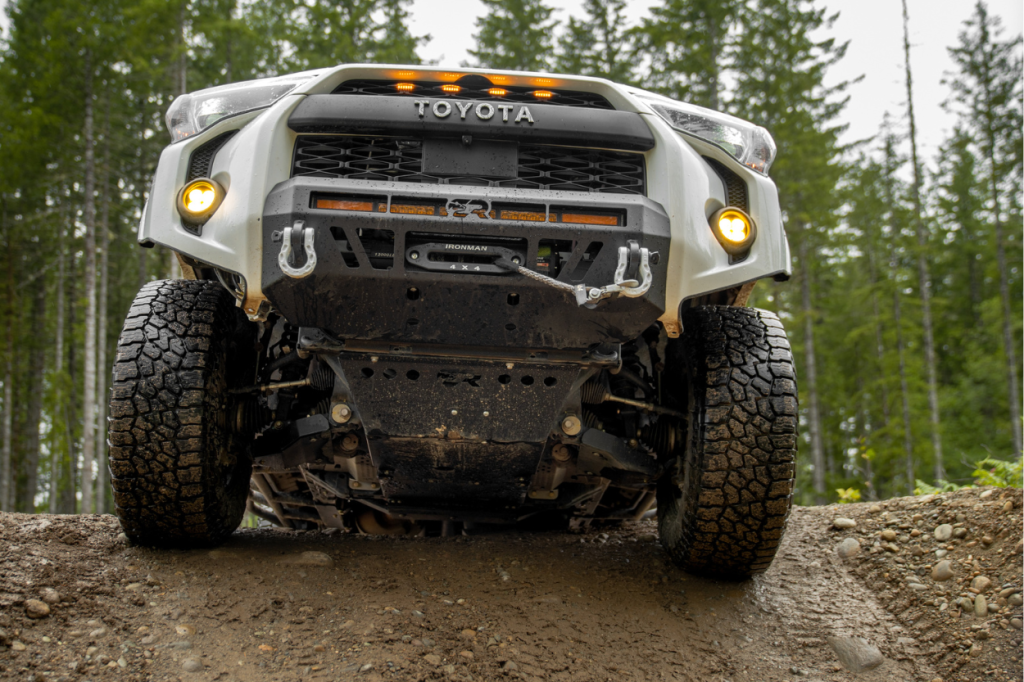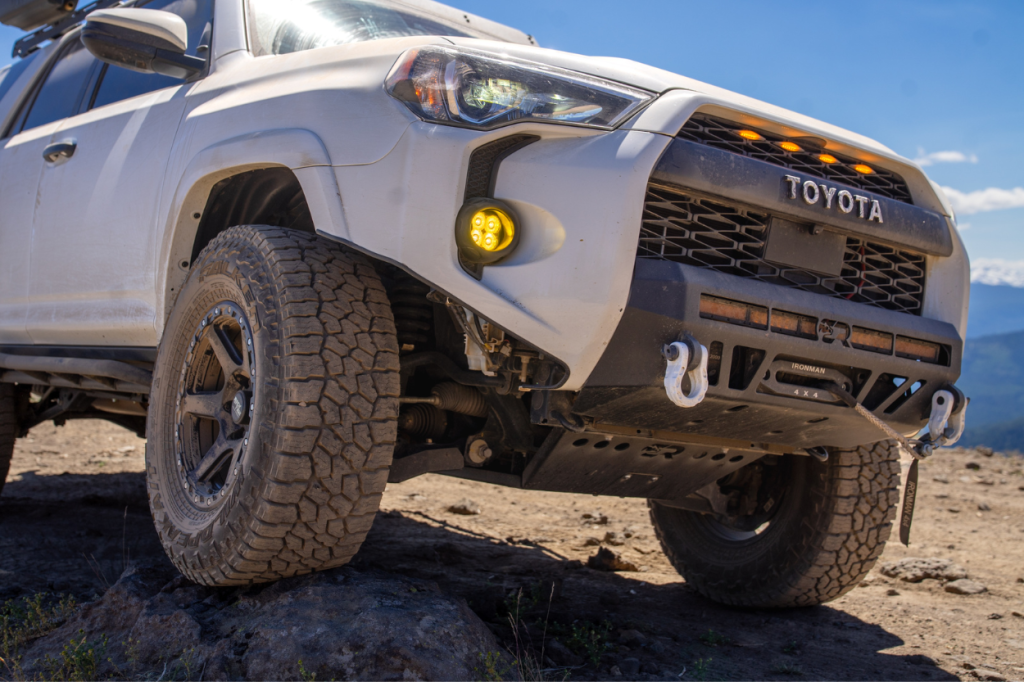
When you’re out on the trails, safeguarding your vehicle and its critical components is a top priority. The most important modification to achieve this is a full set of skid plates for the undercarriage.
Skid plates act as the protective barrier, shielding vital components such as the engine, transmission, and differential from rugged terrain. They can be the difference between a smooth journey and a trailside catastrophe.
Aluminum vs. steel skid plates is an age-old concern with each material having its own pros and cons. In this post, we’ll break down and look at each material in depth. By the end, you’ll have a better idea of which one is the best fit for your needs.
I’ll be focusing on a great option for the 4Runner from Cali Raised. They not only offer both materials, but they have reasonable prices.
Find It Online:
- Cali Raised 5th Gen 4Runner Complete Skid Plate Collection: Check Price
Table Of Contents
Why Does Material Matter?

When it comes to aluminum vs. steel, there is a distinct difference in performance and overall effectiveness.
Steel is known for its exceptional strength and durability, and is ideal for rugged off-road conditions. It provides the best protection against rocks and tough trails, making it the ideal choice for hardcore rock crawlers.
On the other hand, aluminum is a lightweight alternative with corrosion resistance. Its weight savings can result in improved fuel efficiency and drivability and make it a better option for on-road and mild off-road driving.
Why does the material of your skids matter so much? Well, steel skid plates are extremely heavy and are more susceptible to rust. Aluminum skid plates aren’t meant to take the level of abuse that steel can and cost significantly more than steel. Choosing between the two will impact your ride performance and overall use of your truck.
A important feature to note, aluminum being a softer metal, tends to “grip” rocks more than steel does. Steel tends to slide more easily over obstacles. Aluminum causes more friction.
So, how do you know which to pick? Let’s look at a few key differences.
Price

When it comes to aluminum vs. steel skid plates, cost can become a defining factor. Generally, aluminum skid plates cost noticeably more than their steel counterparts. The difference in price point varies from company to company – some differences are large and some are smaller.
Since we are looking closely at Cali Raised, here’s a look at the pricing of Cali Raised LED’s skid plates for the 5th Gen 4Runner. These prices are pretty much spot on as of 9/19/23.
- Steel (Raw): ~$1325
- Steel (Powder Coat): ~$1525
- Aluminum (Raw): ~$1450
- Aluminum (Powder Coat): ~$1620
Regardless of material, though, consider the long-term savings skid plates provide from having to replace damaged components.
Weight

The weight difference between steel and aluminum skid plates has a tangible impact on your vehicle’s fuel efficiency. According to a handful of sources, for roughly every additional 100 lbs. of weight added to your vehicle, there can be up to a 1-2% decrease in gas mileage. As such, steel will impact your fuel economy more than aluminum.
Aluminum skid plates can be about 35-50% lighter, saving you around 50-70 lbs. compared to steel counterparts. However, you must consider their resilience. Steel skid plates, like the Cali Raised ones, are just over 160 lbs. for the entire set and are very robust. Their aluminum skids, however, are just under 80 lbs. for the set.
One compromise could be to use thinner steel such as 1/8″ steel. This saves weight while maintaining protection. Currently, Cali Raised offers skid plates in both 3/16″ steel and 1/4″ 5052 aircraft-grade aluminum.
Skid plates can also significantly impact your vehicle’s performance. For example, lighter plates save weight, thus causing less stress on your drivetrain. That’s something to consider if you don’t quite need the level of protection that steel provides.
Durability

Durability is one of the most important factors when selecting the right material for your truck.
Steel offers strength and resilience, capable of absorbing impacts and navigating challenging terrains with confidence. They don’t easily sustain impact damage and are tried and true protection that rock crawlers trust. If your off-road adventures involve rocky trails and challenging obstacles, steel skid plates could be a solid choice. Keep in mind that you’ll want to touch up scrapes to prevent corrosion.
Still, aluminum skid plates are pretty strong due to their thicker construction. They don’t easily corrode, so there’s no rush to break out the touch-up paint. When things get bumpy, these plates can bend without breaking, thanks to aluminum’s flexibility. Although they can take a beating, they’ll likely show more battle scars, though. For milder off-roading, aluminum is a good choice.
Steel also has an advantage when it comes to repairability. Dents on steel skid plates can often be hammered back into shape without the risk of cracking. Aluminum, on the other hand, can develop cracks, and dents cannot be as easily repaired.
Regardless of your choice, it all starts with high-quality steel or aluminum. Choosing well-made materials ensures that your skid plates provide reliable protection for your vehicle’s vital components.
Design

Design is a huge factor in shaping the performance of skid plates.
When reviewing the design of plates you should take these things into account:
- Coverage & Protection: A well-designed skid plate should provide comprehensive coverage to safeguard vulnerable components underneath the vehicle. It should extend sufficiently to shield essential parts.
- Material Thickness: The thickness of the plate material matters, such as 3/16″ or 1/4″ steel. These offer enhanced durability and better resistance to impacts compared to thinner materials.
- Mounting Points: They should be securely mounted to the vehicle’s chassis using robust attachment points. Look for features like reinforced brackets and adequate fasteners.
- Ground Clearance: Make sure they don’t hang too low to prevent unnecessary drag and interference with obstacles.
- Approach & Departure Angles: Consider how the design affects the vehicle’s approach and departure angles. They should not worsen your capabilities in this aspect.
- Airflow & Ventilation: A good designs include holes for proper airflow, ventilation and debris clearance to prevent overheating of components.
- Weld & Finish Quality: Welds should be clean and strong while optional finishes should be quality a powder coat.
Location

Where you live and where you plan to explore play a big role in material choice.
If your off-roading involves rocky landscapes or rugged trails, steel skid plates might be your best bet. They’re designed to handle harsh impacts, making them a better choice for places with lots of rocks.
On the flip side, if you’re more into milder trails or live in an area that uses lots of road salt in the winter, aluminum skid plates may be a better option.
Hybrid Approach – Mix & Match Metals

In finding the perfect balance between durability and weight, some people decide to mix steel and aluminum skid plates. Steel for the parts that are most likely to take a beating, and aluminum for areas where weight reduction and corrosion resistance are priorities. Does this combination truly deliver the best of both worlds?
From what I’ve seen, many people opt for aluminum for the front and gas tank and steel for the transmission and transfer case. Aluminum can handle the lighter impacts up front, while steel takes the brunt of the force in the midsection where high centering might occur.
Some argue for a reverse approach, suggesting steel skids for the front and gas tanks and aluminum for the midsection. Rocks are more likely to impact the front end during the approach, while the midsection deals with drops and high-centering situations.
Despite these arguments, many think that mixing skid plate materials isn’t the best option. It’s up to you to decide what’s best for your build.
Which Option Should You Pick?

Now the million-dollar question is, which option should you go for?
To be honest, there is no right answer. It depends on what you plan on using your budget for, where you live, and what your price point is. Both aluminum and steel have their benefits and trade-offs.
If I were to give any advice, read through the forums and do your due diligence with brands. See what people are saying about specific sets and from there, figure out your build.
Here are some examples; if you are:
- Looking to save money – Steel
- Looking to save weight – Aluminum
- Looking for durability to bash on – Steel
- Looking for added protection just in case on mild trails – Aluminum
My Setup

I opted for the Cali Raised LED full skid plate kit in steel and got them powder-coated black. This was the best option for me because I do a ton of off-roading. While I’m not doing anything crazy by any means, here in Washington we always have lots of rocks and stumps on our trails and I didn’t want to take the risk. I do occasionally tackle smaller rock gardens as well.
I also wanted to feel a little more centered because I previously only had a front bumper, making the 4Runner very front-heavy. The addition of the heavier skid plates helped evenly distribute the weight throughout the truck. Plus, I have no plans on adding any weight to the rear.
Why didn’t I pick aluminum? It’s simple, I wanted something that would last. Although aluminum has many benefits, so does steel. For me, the most important benefit is steel’s longevity. Building your truck is already expensive as it is, and I didn’t want to have to potentially switch out my setup a few years down the road. I also wanted to make sure all of the vital components were as protected as possible.
Why Cali Raised? They had a comprehensive kit that would protect everything from front to back without having to buy multiple pieces – at a great price and low lead times. Many other brands don’t offer a gas tank skid plate and tend to be a bit more expensive. When you bundle the entire kit, you get a sweet discount too.
Final Thoughts

At the end of the day, this is your build and you should make decisions based on your needs. My goal wasn’t to sway you toward one way or the other, but instead to provide you with as much relevant information as possible to make an informed decision.
Comment below and tell us your thoughts on this debate between aluminum vs. steel skid plates. What setup did you choose and why?

Does “PNW Overlanders” have a web page?
Hello!
We have an Instagram account @pnw.overlanders
Thanks,
Marie
Very informative. Thank you.
Hi Robert,
Thank you so much!
Good info. I went with aluminum from Greenlane Offroad and OK eXpedition. Both have excellent customer service and are based in BC.
Hi Ray,
Thanks so much! I have heard great things about OK eXpedition